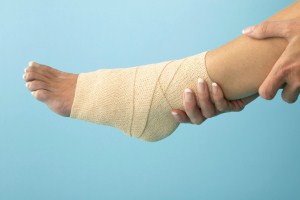Most people are understandably confused about what constitutes a sprain and what constitutes a strain. Both injuries cause pain and can interfere with your ability to move. The difference is really quite small: a strain involves injury to a muscle or tendon and a sprain involves injury to a ligament.
 Tendons are the type of connective tissue that attaches your muscles to your bones. Strains happen when a tendon or muscle becomes overstretched or excessively stressed, losing much of its ability to contract, either during an acute injury or over time. If the injury happens over a length of time, it is referred to as an overuse injury. Carpal tunnel syndrome from excessive use of a keyboard is an example of this type of strain injury. Symptoms of a strain injury include weakness, local pain or tenderness and muscle spasms. One of the most common kinds of strain injury occurs when people hurt their back muscles by trying to lift something that is too heavy in an improper manner (by lifting with the back instead of the legs).
Tendons are the type of connective tissue that attaches your muscles to your bones. Strains happen when a tendon or muscle becomes overstretched or excessively stressed, losing much of its ability to contract, either during an acute injury or over time. If the injury happens over a length of time, it is referred to as an overuse injury. Carpal tunnel syndrome from excessive use of a keyboard is an example of this type of strain injury. Symptoms of a strain injury include weakness, local pain or tenderness and muscle spasms. One of the most common kinds of strain injury occurs when people hurt their back muscles by trying to lift something that is too heavy in an improper manner (by lifting with the back instead of the legs).
Ligaments (the connective tissue that attaches two bones to each other at a joint) are intended to help support the movement of a joint only in specific directions. For instance, the joint at your knee is a hinge that allows for forward and backward movement, though in normal situations it only allows for very limited side-to-side movement at the joint. Sprains occur when a ligament either stretches excessively, tears or completely separates due to acute stress that puts the joint out of place and subsequently injures the ligament. Symptoms of a sprain are more outwardly obvious, involving swelling, bruising, pain and instability around the joint.
Both sprains and strains are placed into one of three categories based on severity:
- Grade I. A minor injury to the muscle, tendon or ligament involving a slight overstretching or minor tearing.
- Grade II. A moderate injury to the muscle, tendon or ligament in which the tissue is partially torn but still connected.
- Grade III. A severe injury to the muscle, tendon or ligament that involves a complete rupture of the affected tissue.
- A physician should be consulted in the case of a severe sprain or strain. Treatment for mild to moderate cases of both types of injuries is the same: RICE.
- R is for Rest. Do not move the injured part for two or three days after the injury.
- I is for Ice. Apply ice to the sprain or strain for 10-20 minutes every 2 to 3 hours for the first 3 days.
- C is for Compression. Wrap the injury lightly but firmly in a compression bandage to support the joint and help keep swelling down.
- E is for Elevation. Keep the injury elevated to reduce swelling.
Sprains take longer to heal than strains, as ligaments have less blood supply than tendons and muscles. The severity of the injury obviously also influences the amount of recovery time needed. A Grade I sprain generally heals within 1 to 3 weeks while a Grade II sprain heals within 6 to 8 weeks and a Grade III sprain can take up to a year to heal.
